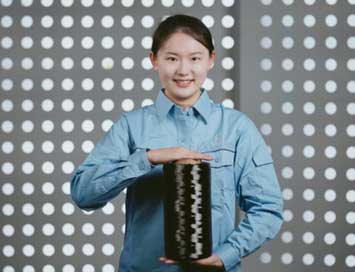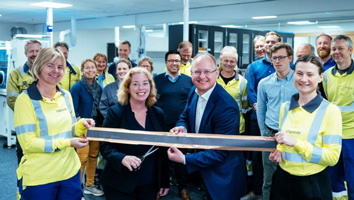Technology: Sinopec’s breakthrough in large tow carbon fibre; Vianode opens R&D centre for sustainable battery materials in Norway

China Petroleum & Chemical Corporation (Sinopec) says it has successfully produced China's first batch of large tow carbon fibre at the company's production base in Shanghai, making the company the first in the country and fourth in the world to possess large tow carbon fibre technology.
Sinopec's production line has adopted its self-developed PAN (polyacrylonitrile) base large tow precursor and carbon fibre technologies. The project is being implemented in two phases and expects to be in full production in 2024, projecting a production capacity of 24,000 tonnes/year of protofilament and 12,000 tonnes/year of large tow carbon fibre.
Large tow carbon fibre refers to roving that contains 48,000 filaments or more. The high-performance material is often referred to as the "king of new material" and "black gold." The product developed and manufactured by Sinopec Shanghai is a new type of high-strength carbon fibre with a carbon content of over 95%. It has outstanding excellent mechanical properties and a specific gravity that's less than one fourth of the steel, yet a strength that's seven to nine times stronger. It is also corrosion resistant.
As the material can be widely used in producing parts and components, it is expected to be used for an increasing amount of industrial infrastructure projects in China, including ones related to wind power, solar power, high-speed rail, and aviation.
"Sinopec has customised a special production line for large tow carbon fiber, including production equipment and techniques, which has enabled us to design oxidising furnaces and carbide furnaces that revolutionises not only the core technology of temperature field control, but also has a revolutionary energy-saving design, marking a major milestone in the development of China's carbon fibre industry," said Huang Xiangyu, carbon fibre expert and deputy general manager of Sinopec Shanghai.
Sinopec now owns 251 patents related to carbon fibre and 46 patents for carbon fibre composite materials, the largest number in China and third in the world, and through scaled up investment and industrial layout, Sinopec adds it is committed to being a major contributor to the development of China's carbon fibre industry.

In other news, Vianode, owned by Elkem, Hydro and Altor, says it is now able to produce advanced battery materials with a greener footprint. The opening of Vianode Technology Centre (VTC) in Kristiansand entails that Vianode will expand its R&D efforts, including a new office, laboratory and recruitment of more battery materials scientists. This is an important step towards establishing a complete battery value chain in Norway for the European market.
Analytical instruments, equipment for advanced electrochemistry testing and an application laboratory focused on the use of Vianode’s materials in battery manufacturing are installed. Today, the VTC has 16 employees from nine nationalities. The plan is to increase the number of VTC employees to 20 by the end of the year and then to 25 by the end of 2025.
”Our materials are produced with up to 90% lower emissions than today’s standard anode graphite materials, with unique characteristics enabling faster charging, increased range and better recyclability. Still, it is essential to keep a dedicated focus on continuous improvement and next-generation battery materials going forward. VTC is established next to Vianode's industrial pilot, only a short drive away from our planned first phase plant at Herøya. This will ensure that industrialisation and R&D go hand in hand,” says, Stian Madshus, general manager and VP in Vianode.
“Our previous R&D facility was funded by the national catapult arrangement Future Materials and was an excellent starting point for Vianode as we got going, but now that we are a larger company a dedicated facility is needed. The opening of the VTC will be a major boost for the organisation and our work,” says Bridget Deveney, R&D Director in Vianode.
Vianode recently announced an investment of NOK2 billion in a battery materials plant at Herøya, Norway, targeting production of anode graphite for about 20,000 electric vehicles (EVs) per year by 2024.
This investment is the first phase in a larger investment plan. The plant construction will be carried out in parallel with preparations for a second phase plant scaled to provide battery materials to 2 million EVs per year by 2030, covering a significant share of the global EV market.
Today, an EV contains on average up to 70 kg of graphite materials, representing a vital component of the battery. Vianode’s products are developed based on specialised know how in high-temperature processes, closed production systems, lower energy consumption and access to renewable energy.
The VTC was funded by Vianode. Vianode receives funding for R&D activities at the site from the Norwegian Research Council (NRC) and Innovation Norway, as well as EU research funding, including the Horizon Europe programme.
Vianode is built upon technological advancements and decades of industrial experience, backed by Elkem, Hydro and Altor. Following successful pilot production, the company is now scaling up towards full scale production in Norway. Vianode’s range of anode graphite products are said to offer performance characteristics and are produced with up to 90% lower CO2 emissions than today's standard materials.
(IMA)Subscribe to Get the Latest Updates from IMA Please click here
©2022 Injection Moulding Asia. All rights reserved.


















